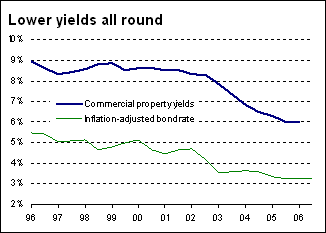A turning point for property yields?
The popularity of property investment this decade has led to declining yields across the board, with rising prices hitting the returns available from residential, commercial, industrial, and even accommodation buildings. With lease agreements coming up for their 2-3 year renewal, the property sector is now in the midst of a period where landlords are looking to recover some of the ground lost during the price boom of the last few years. Building owners almost always hold the upper hand in these negotiations, but current economic conditions suggest they may not have it all their own way this time around.
Indices from Quotable Value show a 74% rise in industrial property prices over the four years to June 2006, and a 50% increase in commercial property prices over the same period. Data from Statistics NZ also shows that commercial property rents recorded their largest annual increase in 2006 since the series began in 1994. But the 3.8% average rent rise is still very modest given property price movements.
Our graph indicates that a downward trend in property yields has been prevalent since 2002/03. However, it also shows that bond yields have tracked a similar course. Taking the 2016inflation-adjusted government bond as a proxy for the risk-free rate of return suggests that the premium commanded by commercial property investment has not shrunk as far as the drop in yields would imply. The same is true for other property types, including residential.

It may be difficult to see on the graph, but the commercial property premium is smaller than at any time in the last decade. So landlords are looking to restore the premium for investing in property. However, as property price inflation slows, there is also an element of future-proofing taking place. The risk-free rate of return is at historically low levels, and any lift would create significant pressure for an upward correction in property yields. Such an outcome can only be achieved through higher rents or lower prices — the latter being the more likely if a sudden correction is required. And there have been some warning signs from bond rates over the last three months, edging up 0.3 percentage points to their highest level since April 2005.
Medium-term prospects for industrial property prices seem solid, despite the negative effects of the high New Zealand dollar on manufacturing. The shortage of vacant industrial land in Auckland and Wellington, in particular, has maintained investor interest. Increasing demand for industrial land from non-traditional areas (such as bulk retail) has also been a factor behind the surge in prices. Investors in industrial property are likely to be willing to accept relatively low yields if they expect the land shortages to persist for some time, pocketing the capital gains from rising property values instead.
Prospects for commercial property are less clear. Total employment has declined by 0.6% over the last six months, and growth will remain subdued throughout much of 2007. Demand for commercial space has stayed robust so far, although if the building is of a lower quality or in the wrong part of town, vacancies have become more of a problem. Refurbishment is becoming important for second-tier buildings, and the focus of construction work is shifting in this direction following a number of large new projects over the last couple of years.
Recent improvements in retail sales activity line up with rebounds in business and consumer confidence. However, an impending interest rate hike (or two) by the Reserve Bank could yet stunt this pick-up out of last year’s slowdown.
Retailers’ margins have come under pressure: intense competition and slower spending growth have cramped revenue, while rising labour costs and transport costs have increased overall expenses. Add in the prospect of hefty rent rises and the squeeze on profits could be too much for some businesses. Retail property owners will need to tread carefully when reviewing rents, or a rise in vacancy rates could quickly undermine the boost to yields they are trying to achieve. The risk of this scenario is that commercial property values could give up some of the gains enjoyed over the last four years.

















